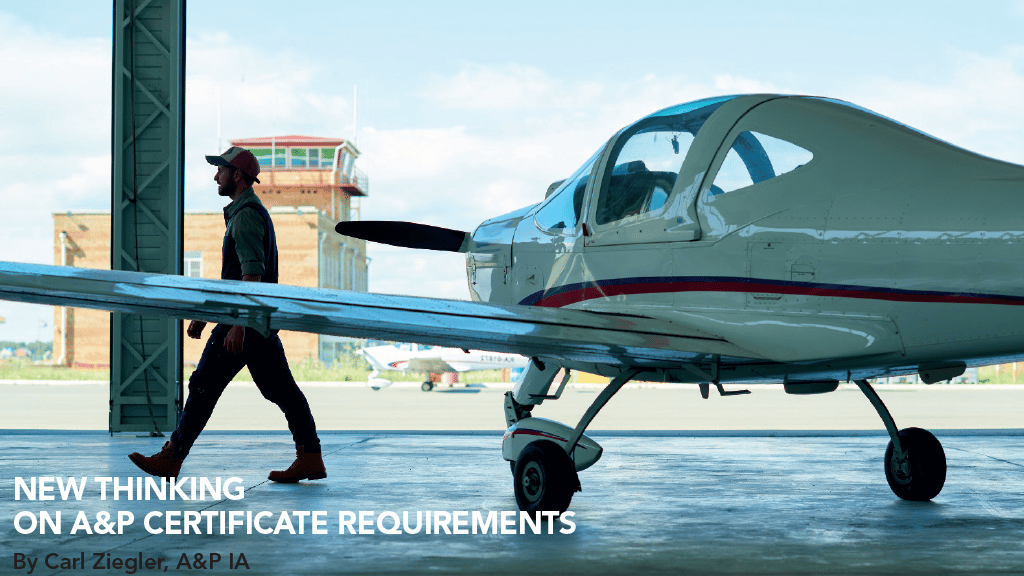While I was standing under the wing of an Airbus, an unfamiliar mechanic approached me and said, “Hey Carl, I heard you have your IA. I’ve had my mechanic’s license for three years now and was thinking of getting my IA, so I could work on little airplanes on the side. Can you give me any advice?” I asked, “Have you ever worked on a 58 Piper Apache or a 71 Skyhawk or a Piper Navajo?”
“No,” he replied. “But I got my license here at the airline and I’m pretty sure I can pass the IA test,” he said.
What would you say? Qualified? Capable? Safe?
During the past decade there has been an exodus of experienced technicians from the aviation industry, accelerated by the effects of Covid on the country. Air carriers in particular have been affected by this exodus and recently, just as the pilot shortage has spurred lowered requirements for cockpit crews, carriers and MROs have started in-house internships and programs to fill those vacated technician spots. The use (past and present) and acceptance of experience requirements as indicated in FAR 65.77 (b) has allowed applicants to gain certification based primarily on tactile time versus both tactile and knowledge learning, as would be acquired from a certified aviation maintenance school. While mentoring has certain merits for training, it is not a substitute for learned knowledge in such varied fields as we routinely find ourselves immersed.
The general aviation scene is even worse than the airlines, specifically as far as the skill set of new mechanics entering the workforce. Airlines and MRO businesses are addressing this with mentoring programs meant to give applicants the required hands-on experience to satisfy the hours requirement for the FAA A&P license. While this may be great for the larger businesses that can afford these programs, it appears everybody else (including the FAA) has ignored the lack of talent required to maintain the more than 200,000 general aviation aircraft operating today. The only license training available for general aviation maintenance technicians is that which is provided by Part 147 technician schools. As a result of these issues and problems I am seeing in the industry, I have proposed a Notice of Proposed Rulemaking (NPRM) to modify technician license requirements for Part 65 applicants.
I propose to break the AMT license into an “unlimited rating” and a “limited rating”. In a nutshell, the unlimited rating would be afforded those that have gone to an approved Part 147 school. General aviation (GA) maintenance skills are continually deteriorating due to the loss of skilled technicians and the influx of new technicians that have only acquired the rating based on tactile time with no formal classroom training. The intent of the proposal is to provide ongoing and future safety margins for the general aviation fleet, in particular, because those individuals that are licensed on a “tactile hours”-based process are not necessarily qualified to work on light aircraft. Conversely, airline maintenance programs are structured and have oversight protection not available in GA Part 91 operations. This disparity in the skills gap has grown substantially, specifically in the last five to ten years. I feel it is time for an evolutionary change to help maintain the thin safety margins that we now have.
The “limited rating” license is predicated on the type/category or model of aircraft that the applicant has accrued the required tactile experience for sign off to take the written, oral and practical crash tests. The limited rating starts you off at the FAR work level you based your experience on. In order to move down to the GA level, an IA would endorse your skill level for makes and models. To move up to the transport level would be seamless, as mentioned above, since the airline operations have more structure and oversight, as well as additional training available.
An additional significant benefit to this proposed change is that it will afford a mechanism to facilitate mentorship, cited as a major issue in several industry publications, with no additional cost to consumers, to help mitigate the skill decline and knowledge gap that continues to widen with each passing quarter. This will also emphasize the importance of certificated maintenance training schools in the industry and hopefully provide incentives to further expand training initiatives and continuing investments in such.
An in-depth overview and operation of proposed changes to FAR 65 is online in the NPRM proposed rules docket section of Regulations.gov FAA-2023-0050-0001. Carl Ziegler can be reached at planemech@yahoo.com.
